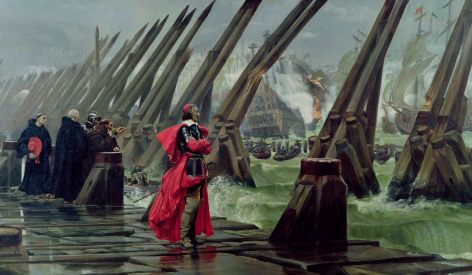The Destructive Ride of the White Horse of Revelation
The rider on the white horse of Revelation can be confusing. What does he represent? How does his ride lead to the destruction brought by the horsemen that follow?

Where is the white horse found in the Bible?
The white horse (of the four horsemen of Revelation) is found in Revelation 6:2.
As we explain in our article “What Are the Four Horsemen of the Apocalypse?” the horsemen represent four trends that will have a destructive impact on our world in the end time. But those trends won’t be unique to the end time—they have existed for hundreds of years and affect our world today.
What do the last three horsemen represent?
Consider the trends represented by the last three of the four horsemen:
1. Red horse (war):
Currently the world is at relative peace, especially compared to the 20th century (which saw two world wars). Today we see regional tensions and civil wars in various places around the globe. But, as in the past, a small incident can spark a global conflict. This is particularly true as we see the United States draw inward and withdraw from the world stage.
Last year witnessed the largest military spending increases in a decade (to a total of $1.917 trillion). The top five military spenders are the United States, China, India, Russia and Saudi Arabia, accounting for 62 percent of the world’s military spending. Germany’s increase was the largest of any nation, up 10 percent.
2. Black horse (famine):
The United Nations has warned of famines of “biblical proportion” due to a “perfect storm” of deepening crises. Conflicts, unusual weather patterns, locust plagues, and economic instability caused by COVID-19 could result in over 130 million people experiencing starvation.
3. Pale horse (pestilences):
The COVID-19 pandemic has brought the world to its knees. But the current pandemic will pale in comparison with the deadlier disease pandemics prophesied in the Bible.
The connection between war, famine and pestilence
Throughout history, war, famine and pestilence have often occurred in close proximity to each other. One of the worst modern examples is World War I (1914-1918), which killed around 9 million soldiers, wounded 21 million more and caused around 10 million civilian casualties.
During the war, food production was severely disrupted, and shortages occurred. Both Germany and Britain saw long food lines and food rationing as food was redirected to serve soldiers on the frontline. Toward the end of the war, the Spanish flu pandemic killed 20 to 50 million people.
These are mentioned together as the “sword,” “famine” and “pestilence.” Other places in the Bible show that these three elements of suffering often occur together:
- King Jehoshaphat pleaded with God to deliver Judah from “sword, judgment, pestilence, or famine” (2 Chronicles 20:9).
- Through the prophet Jeremiah, God warned that Judah would be punished “by the sword, by the famine, and by the pestilence” (Jeremiah 14:12).
- The prophet Ezekiel prophesied that two-thirds of end-time Israelites will die by pestilence, famine, wild beasts and the sword (Ezekiel 5:12).
The meaning of the white horse of Revelation
Warfare, famines and pandemics are easy to see and document throughout history. But many miss the significance of the white horse—which often gallops invisibly, with its effects not as well noticed. What does the white horse in Revelation mean? The rider of the white horse represents the trend of false religion.
In the Bible, the color white often represents righteousness (Revelation 3:5; Isaiah 1:18). Jesus is pictured as returning on a white horse (Revelation 19:11).
Because of this, some have mistakenly concluded that the rider of the white horse is Jesus Himself. One of the earliest people to associate Christ with the white horse was Irenaeus, a church writer of the second century.
To understand what the white horse represents, we must allow the Bible to interpret itself. The four horsemen become visible as Jesus is opening the seals of a prophetic scroll (b]to loose its seven seals.”
6 And I looked, [c]and behold, in the midst of the throne and of the four living creatures, and in the midst of the elders, stood a Lamb as though it had been slain, having seven horns and seven eyes, which are the seven Spirits of God sent out into all the earth. 7 Then He came and took the scroll out of the right hand of Him who sat on the throne.
8 Now when He had taken the scroll, the four living creatures and the twenty-four elders fell down before the Lamb, each having a harp, and golden bowls full of incense, which are the prayers of the saints. 9 And they sang a new song, saying:
“You are worthy to take the scroll,
And to open its seals;
For You were slain,
And have redeemed us to God by Your blood
New King James Version (NKJV) The Holy Bible, New King James Version ©1982 by Thomas Nelson">Revelation 5:5-9).
This rider looks like Christ coming on a white horse—but is an impostor.
Jesus reveals the meaning of the first four seals when we compare them with His words in the Olivet Discourse (Matthew 24; Mark 13; Luke 21). By doing this, we see that the red, black and pale horses represent “wars and rumors of wars,” “famines” and “pestilences” (Matthew 24:6-7).
So, it stands to reason that Jesus identified the white horse as well! Preceding His explanation of the red horse, Jesus said: “Take heed that no one deceives you. For many will come in My name, saying, ‘I am the Christ,’ and will deceive many” (Matthew 24:4-5).
The white horse is religious deception. This rider looks like Christ coming on a white horse—but is an impostor.
Let’s look deeper at the description of the first seal. As the first seal was opened, the apostle John wrote, “I looked, and behold, a white horse. He who sat on it had a bow; and a crown was given to him, and he went out conquering and to conquer” (Revelation 6:2 emphasis added).
Each of the symbols connected to the white horse has meaning:
- He carries a bow. This horseman’s weapon is a bow, whereas Jesus’ weapon will be a sword that proceeds “out of His mouth” (Revelation 19:11)—the Word of God (Revelation 19:13). A bow provided a soldier the ability to kill with skill and accuracy from a long distance and, sometimes, with secrecy. The Bible describes Satan as shooting “fiery darts” (or arrows) at us (Ephesians 6:16).
- He goes out “conquering, and to conquer.” Satan is described as conquering the world through deception (Revelation 12:9). He makes himself appear as an “angel of light” and has ministers who appear as “ministers of righteousness” (2 Corinthians 11:14-15). Those who claim that Jesus is the rider say that Jesus is “conquering the world” with the gospel. But that is not the case, as most people in today’s world don’t understand the true Jesus Christ or the gospel He taught. It is Satan who has conquered the world through deception (Revelation 12:9; 2 Corinthians 4:4).
- The horseman wears a “crown.” Satan is the “god of this age.” He blinds people and prevents them from believing in the gospel (2 Corinthians 4:4). He, and the false religions of this world, have temporary dominion. (When Jesus returns, that dominion and influence will be removed.)
The white horse will ride with great intensity in the end time, but the trend of false religion has been impacting our world for thousands of years.
The destructive consequences of false religion
Satan’s deception goes all the way back to the Garden of Eden. In the garden, Satan presented himself in the form of a serpent to Adam and Eve and lied to them about what was good for them—in a very cunning and deceptive manner. He suggested they eat from the tree God had commanded them to avoid (Genesis 2:17; Genesis 3:4).
Eve was deceived by “his craftiness” (1 Timothy 2:14). Adam was not deceived, but chose to follow his wife.
Cardinal Richelieu overseeing the Siege of La Rochelle (1627-1628), where French Catholic forces ultimately defeated the Protestant French Huguenots. (Source: Musée d'Orbigny Bernon.) 
In Genesis 4, we see how violence entered humanity through Cain’s murder. Rejection of God’s authority leads to violence—pictured by the red horse.
It is spiritual deception that is at the root of most of humanity’s problems—including wars and the resulting famines and pestilences.
Because false religion has so many varieties, it has driven wedges between people for thousands of years and has been a factor in nearly every human conflict.
Though all false religions have one thing in common—rejection of God’s true laws—Satan has been able to use the subtle differences between them to inspire hatred and warfare.
Consider just some of the wars fought in the name of Christianity:
- Charlemagne: Known today as the “father of Europe,” he reigned from 800 to 814 as the first emperor of the Holy Roman Empire. With a goal of spreading Christianity, he waged a series of wars against the pagan Germanic tribes across Europe. In 782, in what’s become known as the Massacre of Verden, he killed 4,500 Saxons in a bid to convert the Saxons to Christianity.
- The Crusades: In 1095 Pope Urban II called for a crusade to secure Christian control of the Holy Land by driving out the Muslims, claiming “God wills it!” This was the start of a series of eight crusades that finally ended in 1291. The Crusades were known for their brutality and ruthlessness.
- Thirty Years’ War: One of Europe’s most savage wars, waged from 1618 to 1648, was between Catholics and Protestants. This war resulted in 8 million casualties.
Many other wars have not been directly caused by religion, but included religious and cultural differences as a factor. For instance, though religion isn’t usually listed as a cause of World War II, Hitler’s hatred of certain minority groups that weren’t Catholic or Lutheran—the majority religions in Germany—was the motivation for many of his most violent actions.
False religious ideas have caused many wars, which have often led to famine and pestilence. Prophecy shows that religious deception will become even more powerful and influential in the end times.
In our next blog post, we will take a closer look at the ride of the white horse in the end times.
To learn more about this topic, read our blog post "Are the Four Horsemen of Revelation Riding Today?"
Date Posted: June 12, 2020



